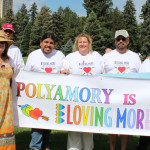By Maureen Marovitch
Reprinted from Loving More Issue #33, Winter 2005.
I’m going to say something that’s going to get me into water hotter than those at the Harbin Hot Springs.
Swingers and polyamorists have a lot in common.
I can hear the howls already. How ridiculous! Polyamory is all about relationships, sharing lives together, creating more love. Swinging is all about ‘recreational sex’, instant gratification, lust without love.
~~
It’s so comforting to have tidy labels: Swingers do sex. Polyamorists do love. Swinging is fast food. Polyamory is a gourmet meal. Swinging is cheap. Polyamory is rich. Swinging is fucking. Polyamory is sensuality.
~~
The problem with labels is that they’re so small and the groups of people are so big. Some in the mass shift a little and the labels start to strangle. Or they fall off and you’re making a mess trying to stick them somewhere else.
~~
If we start peeling the labels off and the clothes with them, then both groups start to look more and more alike. True, there are always the far ends of any spectrum. At one side of the bedroom are those who practice long-term polyfidelity, intending to remain sexually and emotionally faithful to their partners until death do them part. On the other side, there are those who insist on anonymous sex with those whose names they don’t even know. But what about the sprawling king-sized bed in the middle where the desires, interests and perhaps even political alliances of both groups meet?
~~
 The people you’re going to meet in this article practice swinging and polyamory. They’ve all danced to the drumbeats at Loving More conventions, contributed to the discussion circles there, maybe even led a workshop. A few weeks later, they were entering the on-premises room at a swingers’ club, en route to a sexual encounter with a couple they met earlier that evening. Does that make them somehow ‘un-poly’, traitors to the ideals of polyamory? Is there really an ‘us’ and a ‘them’?
The people you’re going to meet in this article practice swinging and polyamory. They’ve all danced to the drumbeats at Loving More conventions, contributed to the discussion circles there, maybe even led a workshop. A few weeks later, they were entering the on-premises room at a swingers’ club, en route to a sexual encounter with a couple they met earlier that evening. Does that make them somehow ‘un-poly’, traitors to the ideals of polyamory? Is there really an ‘us’ and a ‘them’?
~~
John and Irene met at age eighteen, married two years later, and have now been together just over forty years. In 1967, after the birth of their two children and several years of discussion, they decided to pursue polyamorous relationships. Although they heard about swinging as early as 1971, they didn’t actually try it until the early 1980s. Their first experience was through Family Synergy, a California group that included both those who practiced swinging and polyamory. Since then John says they have done ‘stereotypical swinging’ only a few time, but have regularly participated in the more ‘poly-friendly’ style of sexual encounters: group erotic ritual, erotic massage and sex with small groups with some of their poly partners.
John and Irene practice a form of polyamory based on networks of intimate friendships. It is this model of polyamory more than any other that most closely resembles swinging. In this loosely knit grouping of loving, sexual friends, some relationships are fleeting while others may last for decades, either remaining sexual or changing into platonic friendships But John points out that several of these ongoing poly relationships actually began as sexual contact with those he’d just met swing parties. Says John, “Until on-line communication emerged in the ‘90s, it was a real problem to find like-minded-people. Swing events became a way for us to find people who more interested in being poly."
~~
But if a search for polyamorous partners explains John and Irene’s initial forays into swinging, why haven’t they left it long behind now that polyamorists are relatively easy to find? They still go to swing clubs because they enjoy the sexual atmosphere, and have even found ways to mix it with polyamory. “I get a group of adventurous poly friends, we go to New Horizons (a swinger club in WA) and have a good time. If people are attracted to us, that’s fine. But sometimes we just go out and make love among ourselves, soak up the sex energy and eye candy. It’s just a wonderful sex positive environment.”
~~
 “The myth about swinging is that it’s all about sex with strangers. That’s simply not so,” insists John, as he describes one of his early experiences at a swinging house party. “We (a lover and I) went to a party at a big middle class home in Vancouver, WA where there were fourteen or fifteen other couples. We had sex with people we had just met that night. When the party wound down, after all you can only fuck for so long, the owners of the house and two other couples sat around the fireplace talking about how they were going to pour a concrete driveway for one of them the next day. For me, the quintessential U.S. neighborly thing is a barn raising, and that’s essentially what they were doing. They weren’t going to have orgasm pouring concrete. They were building their homesteads together.”
“The myth about swinging is that it’s all about sex with strangers. That’s simply not so,” insists John, as he describes one of his early experiences at a swinging house party. “We (a lover and I) went to a party at a big middle class home in Vancouver, WA where there were fourteen or fifteen other couples. We had sex with people we had just met that night. When the party wound down, after all you can only fuck for so long, the owners of the house and two other couples sat around the fireplace talking about how they were going to pour a concrete driveway for one of them the next day. For me, the quintessential U.S. neighborly thing is a barn raising, and that’s essentially what they were doing. They weren’t going to have orgasm pouring concrete. They were building their homesteads together.”
~~
Greg, 35, and Kristin, 28, make it clear that they aren’t going to swingers’ clubs in search of homesteaders. Says Greg, “We think of swinging like the ‘blitz chess’ of relationships. You know, in parks, the guys who play chess fast with a five-minute timer in a time-limited game? Swinging is like that; it’s a great way to have sex with a lot of people real quick You meet, you get naked, you have sex, you know what sex is like with them, and then you say goodbye. Poly is the gradual ‘take your time’ kind of stuff and the work involved in a real relationship. We get different things from each lifestyle.” Kristin concurs, “ Swinging is a recreational thing for us, a thing we do for fun. Poly is our life.”
~~
Greg and Kristin share a house in Ohio with Kristin’s legal husband Rob and the three co-parent three small children. They wouldn’t entirely rule out the possibility of meeting others they really could care for at a swingers’ event. After all, the two met in 1994 at a swingers’ club. At the time Greg was married to Tina, while Kristin and Rob had been together four months. The two couples began to spend a lot of time together and grew closer, forgoing visits to the swing club altogether. “We hadn’t heard about polyamory then,” says Kristin. “We just thought we were doing swinging wrong.”
~~
Greg and Tina’s marriage didn’t survive the experiment, and the group lost track of each other over the next four years until Greg located Kristin again in 1997. During those years, Kristin and Rob moved away from swinging as they discovered polyamory. The three have been together since but it’s only since the summer of 2002 that Kristin and Greg began exploring swinging again, this time together. “For some couples, they do swinging because they are bored with their sex lives and for others, it’s more like ‘How else can we grow?” says Kristin. “That’s what happened with Greg and me. It’s an experiment we’re trying in sex ‘positivity’.”
~~
Kristin offers up an experience from this past summer when she and Greg attended the Loving More Convention. Kristin and Greg started chatting about their fantasy wish list with a conference attendee they had met the day before. It turns out their fantasies jibed nicely with his, and with those of another attendee. That night Kristin found herself in a tent with three men living out their fantasies. They danced under the moonlight because that was one of their wishes. They all had sex in a variety of ways. At the evening’s end, they talked about how they felt. One of the men said that in the future, he’d like to cuddle more. They exchanged email addresses, hoping to meet up again some day. Was it any different from an adventure at a swingers’ club? Yes and no, says Kristin. “What we did was blending swinging and poly aspects. We communicated much more than we would at a swing club, and it was about four loving people being sexual together, but it was definitely not the start of a relationship.” Is there something wrong with that? Kristin doesn’t think there is, though those who subscribe to more emotionally binding, less casual poly forms might disagree. “We all want to fall in love so that makes it okay to have sex, as if somehow sex for fun is wrong.”
~~
I thought I was pretty positive and open-minded about sex in all its forms, but my first two visits to swinger conventions made me feel like a virginal, nineteenth-century school marm who accidentally stumbled into a big city bordello. I was attending swinger events as research for a feature film script I was developing. I found I was both repelled and attracted to swinging in equal measures. Some individuals seemed downright predatory while others were playful flirts. Some of the outfits that people showed up in were tacky and the venues tawdry, but if I was in the right mood, they were fun or sexy. The people were so shallow, so superficial; it seemed all about cruising for a quick meshing of sex organs. But then I met others I found to be engaging, interesting and not looking to jump right into my knickers or at least not necessarily in the first ten minutes. Once I got past how different it all looked from polyamory, things began to seem more familiar. Not the same as polyamory, but not as different as you might expect. And I was forced to question my notion of what kind of sex was ‘good sex’ (i.e. sex with a friend or lover) or ‘bad sex’ (i.e. sex with a stranger).
~~
But if swinging and polyamory aren’t opposite ends of the spectrum, it would be misguided to say that there are no philosophical or practical differences. I’m not talking about the surface variations, the swinger leather or lace club outfits versus the tie-dyed cottons and Hawaiian shirts at polyamory events. I don’t mean the more sexually explicit swinger personal ads versus the more genteel, romantic poly personals. Nor am I even speaking about the overt sexuality at swinger events versus the more subtle courtship undertones that exist at just about any polyamory gathering. The two differences that stand out most for me are that swinging is a heterosexual and a couple-centric world, while polyamory aspires to be neither.
~~
 At most swing venues, bisexuality is encouraged among women, but sharply discouraged among men-at least in public. Club 104 in Ohio goes so far as to make their Rule # 8 that guys cannot touch each other. Greg, who identifies as bisexual, finds this outlook limiting and sometimes even oppressive, but shrugs it off without much thought. “That’s just the way it is. The rule at any swing club is you don’t even mention you’re bisexual if you’re a guy. But even though guys say that they’re straight, once you’re behind closed doors, you work out whatever deal you want.”
At most swing venues, bisexuality is encouraged among women, but sharply discouraged among men-at least in public. Club 104 in Ohio goes so far as to make their Rule # 8 that guys cannot touch each other. Greg, who identifies as bisexual, finds this outlook limiting and sometimes even oppressive, but shrugs it off without much thought. “That’s just the way it is. The rule at any swing club is you don’t even mention you’re bisexual if you’re a guy. But even though guys say that they’re straight, once you’re behind closed doors, you work out whatever deal you want.”
Kristin thinks it’s the very nature of those who gravitate to swinging or polyamory that self-selects for values and community.
~~
Says Kristin, “Look at the survey results in Loving More, there are more liberal people, more people who are accepting of alternative lifestyles, alternative medicines, more likely to experiment with lots of different things. Most swingers will only experiment within certain perimeters-their experiment is to have intercourse with another woman if they’re a guy.”
~~
Lest we get too holier than thou about those homophobic, conservative swingers and their couple-centric world, Kristin and John give us food for thought about the practical realities of the poly world. Just as swinging purports to successfully divide sex and love, but in practice sometimes does not, polyamory doesn’t always live up to its cherished ideals. “Poly people are more open to male bisexuality,” says Kristin, “But in practice it seems like there are only a few more bi poly guys than there are bi swinger guys.” John also sees a perceptible difference between the theories and ideals of polyamory and how it’s really lived. “Group families are so rare, they’re almost a mythic ideal. Much as I hate to admit it, the reality is that most polys are couple based and they might add one other person, as Irene and I did for a few years in the mid-1980s. Beyond that, the logistics and complications of a multi-partner household are too much for most people.”
~~
Given how little exchange occurs between the two groups, you’d think that swingers and polys inhabit entirely different planets, not just communities. The majority of those who swing have never heard of polyamory, and often the few who have consider it a benignly misguided experiment or the fast track to wrecking a good marriage. Reading the poly email lists, you quickly realize that a number of polyamorists see those who swing as sex-obsessed, or else somewhat pathetic and empty, and a source of bad P.R. for the poly community. To quote from a writer on the Loving More email list, “It’s like there’s this ‘social acceptance of sexual/romantic minorities’ pecking order, and everyone is scrambling to make sure someone ELSE is on the bottom, elevating themselves by keeping others down or stepping on others’ heads.”
~~
“Our entire culture is negative towards sex, and we’ve internalized that.” John says. “We say, Maybe what we polyamorists are doing isn’t always quite true love, but at least we are not some drooling, immoral, mindless morons who will fuck anything. We can then compare ourselves to them in a positive way and we can convince the mainstream that yes, we do this sort of stuff but we’re benign and loving.”
~~
Does that make those who identify with swinging and those who call themselves polyamorists one and the same? At the core, polyamory is about multiple, consensual, sexual, loving relationships while swinging is multiple, consensual, sexual relationships. The absence of the word ‘loving’ does lend a fairly different intent, philosophy and tone to the magazines and gatherings that cater to each group. But that doesn’t stop substantial numbers of self-identified polys from engaging in the same practices that self-identified swingers do - whether those acts be at swing clubs, Sacred Sex Parties, or among casual friends. Nor does that limit some swingers from forming multi-faceted, loving relationships with long-time swinging friends-whether they chose to acknowledge the depth of the relationships or not. For some polyamory purists, these cross-over behaviors seem to be troubling.
~~
“I don’t have a problem with making choices, with friends of mine deciding that something is just not their thing,” says John. “But I do have a problem with people bashing others; especially about something they know nothing about, something they just have their own fantasy about.”
John says that as a strategy, it’s plain foolish for polys to be disrespectful of swingers. “If the first words out of a poly person’s mouth are ‘I’m not a swinger’ how is that going to feel to swingers? Why are we alienating our most likely political allies?” Given that an estimated one to three million North Americans practice swinging in some form, and the number of polyamorists on the continent is perhaps 10% of that, there may well be strength in these numbers.
~~
 But aside from politics, the people I spoke with for this article agree that it’s entirely possible to move between the swinging and polyamory communities, that there is no either/or choice to be made. John and Irene will continue their occasional visits to the New Horizons swinger club and hope to one day live in a co-housing situation with like-minded friends and lovers. Greg and Kristin will continue to attend their local poly discussion group, keep their options open for a secondary partner, and also venture out for a night of recreational sex play now and again.
But aside from politics, the people I spoke with for this article agree that it’s entirely possible to move between the swinging and polyamory communities, that there is no either/or choice to be made. John and Irene will continue their occasional visits to the New Horizons swinger club and hope to one day live in a co-housing situation with like-minded friends and lovers. Greg and Kristin will continue to attend their local poly discussion group, keep their options open for a secondary partner, and also venture out for a night of recreational sex play now and again.
What if we didn’t need to firmly brand ourselves with the polyamorist or swinger labels but instead described ourselves as people who are opting to challenge the mainstream norm of lifelong monogamy? In that world, both polyamory and swinging are part of the same moral code: being open and honest in multi-partner relationships. Now that’s a similarity I can live with.
~~
Maureen Marovitch loves having the chance to be curious and downright nosy under the respectable guise of journalism and filmmaking. She recently co-directed “When Two Won’t Do”, a personal documentary about polyamory, and is currently developing a feature film script set in the swinger community.








Leave a comment